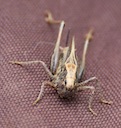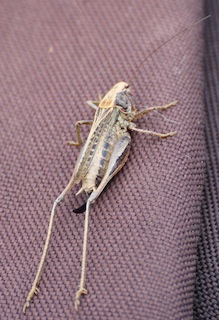 This female Grey Bush-cricket climbed on to a rucksack strap to pose for the camera at Kynance.
This female Grey Bush-cricket climbed on to a rucksack strap to pose for the camera at Kynance.
Photo: Amanda Scott
Scientific name: Platycleis albopunctata
Cornish name: Gryll is the general word for a cricket
Conservation status: Nationally scarce
 The Grey Bush-cricket is a member of the Bush-cricket family (Tettigoniidae). At up to 3 cm in length and mainly grey in colouring (as you would expect from its name), its thorax and the upper part of its head may be browny-green with a yellowy abdomen underside, and both sexes are able to fly. One of the female’s most distinguishing features is the dark, upward-curving ovipositor (the photo at the end of this article shows this clearly).
The Grey Bush-cricket is a member of the Bush-cricket family (Tettigoniidae). At up to 3 cm in length and mainly grey in colouring (as you would expect from its name), its thorax and the upper part of its head may be browny-green with a yellowy abdomen underside, and both sexes are able to fly. One of the female’s most distinguishing features is the dark, upward-curving ovipositor (the photo at the end of this article shows this clearly).
Although there is a very small number of inland records, this is mainly a coastal species occurring in the south-west and south-east and in some locations in Wales (source: National Biodiversity Network). Its habitat is rough grass and vegetation on south-facing coastlines, shingle beaches and dunes, where the adults can be seen from July to October. Its chirping call has been likened to the sound of winding a watch (Chinery, 2005), but you are unlikely to hear it without help from a detector.
Did you know…?
…Globally there are over 6000 species of Bush-crickets, occurring on every continent except for Antarctica. Britain has just ten native species.
…It is the male Bush-cricket who sings (stridulates) to attract females. Crickets produce their song by rubbing their forewings together, in contrast to grasshoppers which rub their hind leg on their forewings.
More information and references:
Chinery, M., 2005. Collins Complete Guide to British Insects. HarperCollins, London.
Published: August 2013
Author: Amanda Scott
Photos: Amanda Scott

